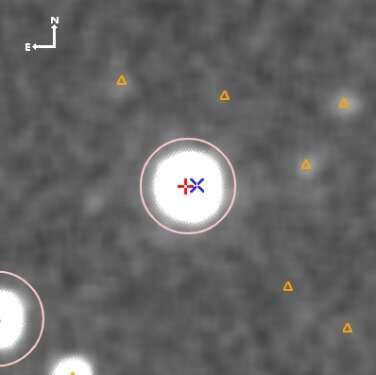January 12, 2021 report
Neptune-sized exoplanet discovered by NGTS survey

An international team of astronomers reports the discovery of a new exoplanet as part of the Next Generation Transit Survey (NGTS). The newly found alien world, designated NGTS-14Ab, is about 30% larger than Neptune. The finding was detailed in a paper published January 5 on arXiv.org.
NGTS is a wide-field photometric survey focused mainly on the search for Neptune-sized and smaller exoplanets transiting bright stars. The project uses an array of small, fully robotic telescopes at the Paranal Observatory in Chile, operating at red-optical wavelengths. It uses the transit photometry method to find new exoworlds, which precisely measures the dimming of a star to detect the presence of a planet crossing in front of it.
A group of astronomers led by Alexis Smith of the German Aerospace Center's Institute of Planetary Research, has detected a new planet as part of the NGTS survey. Photometric observations of NGTS-14, a binary star located some 1,000 light years away, have identified a transit signal in the light curve of NGTS-14A—a K-dwarf in this system. The planetary nature of this signal was confirmed by follow-up observations of this star using NASA's Transiting Exoplanet Survey Satellite (TESS) and various ground-based telescopes.
"Transits of NGTS-14Ab were discovered in photometry from the Next Generation Transit Survey. Follow-up transit photometry was conducted from several ground-based facilities, as well as extracted from TESS full-frame images," the astronomers wrote in the paper.
NGTS-14Ab has a radius of about 0.44 Jupiter radii and a mass of nearly 0.1 Jupiter masses, which implies a mean density at a level of 1,400 kg/m3—suggesting that it has retained some of its primordial atmosphere. The planet orbits its parent star every 3.53 days, at a distance of approximately 0.04 AU from it. Its equilibrium temperature was calculated to be around 1,143 K.
The short orbital period of NGTS-14Ab, together with the fact that it is slightly larger and more massive than Neptune, place it in the so-called Neptunian desert. It is a relatively unpopulated region of parameter space characterized by a dearth of intermediate-mass planets at short orbital periods.
"NGTS-14Ab joins a growing number of planets that reside in the Neptunian desert, a sparsely populated region of parameter space between the hot Jupiters and the super Earths in the radius—period plane," the researchers explained.
The study also shed more light on the properties of the host of the newly discovered extrasolar world. According to the paper, NGTS-14A is about 5.9 billion years old, has a radius of approximately 0.84 solar radii and is 10% less massive than the sun. The effective temperature of this star is estimated to be 5,187 K and its metallicity [Fe/H] was found to be at a level of around 0.1.
When it comes to the second component of the investigated stellar system, designated NGTS-14B, the astronomers assume that it is probably a star of M2.5V spectral type, separated by about 1,137 AU from NGTS-14A. Further observations of this binary are required in order to determine the parameters of NGTS-14B.
More information: NGTS-14Ab: a Neptune-sized transiting planet in the desert, arXiv:2101.01470 [astro-ph.EP] arxiv.org/abs/2101.01470
© 2021 Science X Network





















